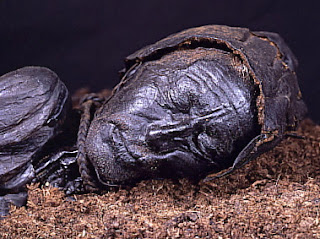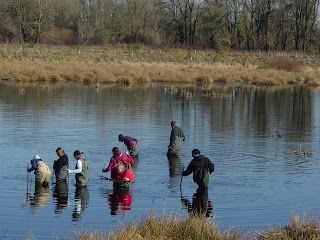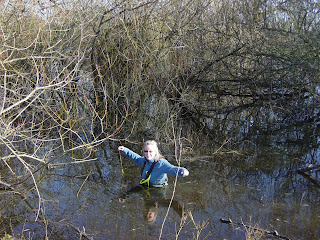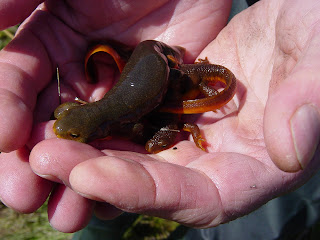The discovery of a body in a marsh just north of here has turned the red-legged-frog-egg-mass-monitoring world upside-down, as you might well expect. Amphibian monitors were indeed credited with the grisly find, and now monitors throughout the greater metropolitan area are quaking in their chest waders. It is all too easy to imagine the scenario.
Dave and I did our first amphibian-egg-mass survey of the year last week. He holds the bamboo stakes and flags and I carry the clipboard and data forms. We insert ourselves into a cold swamp up to just below (ideally) the top of our waders and hunt for frog and salamander eggs. If Dave spots a clump, I stop the stopwatch and ask for details. These include the stage of the eggs, their depth in the water, and what they’re attached to, if anything.
“Attachment: grass, wood, or none?”
Dave would peer into the water and back away. “Ring finger,” he’d intone, while the background chorus of frog bleats is suddenly echoed by banjos, and slowly, slowly, a rising form would break the surface of the water and–but no, no, it’s too ghastly to contemplate. What if his eyes were open? What if he were purple or otherwise unsightly? What if he were someone we had recently disparaged in a public place? Would the fact that our car does not have a trunk be considered exculpatory?
 At least we do not work in peat bogs. Peat bogs in the British Isles have been producing remarkably uncorrupted cadavers for years. They barely deteriorate over the millennia in the anaerobic peat environment. Anyone unearthing one of these is likely to cause the local police department to scour their records for missing persons last seen wearing 2,000-year-old tunics.
At least we do not work in peat bogs. Peat bogs in the British Isles have been producing remarkably uncorrupted cadavers for years. They barely deteriorate over the millennia in the anaerobic peat environment. Anyone unearthing one of these is likely to cause the local police department to scour their records for missing persons last seen wearing 2,000-year-old tunics.
No, our swamps are seasonal ponds, wet in the springtime and summer-lush. The regional government Metro sends us to tromp through them every February to search for evidence of frog and salamander romance, considered a reliable metric of goodness in the world. It can be risky, especially for Brewsters, who are congenitally tippy. My niece Elizabeth abandoned the effort after our first season due to her inherent inability to keep the swamp on the outside of her waders. She was replaced by my husband Dave, who is dependably sturdy when sober and also wears much higher waders. Still, rampaging nutrias and irritable herons are a constant threat. Deep down, the amphibian monitors’ greatest fear is that the body in the marsh is one of us, from a prior year. After we inventory the amphibian eggs, does Metro inventory us?
If there’s no blog post here next Saturday, please give them a call.



I judge the health of my local ecosystem by how many Turkeys wander through after the worst of winter has passed. Just yesterday, a herd of fully grown and roastable adults wandered through my yard. I counted 11. Yeah that's down from their pre-winter number of too many to count cuz the damn things won't stay still long enough to get a reliable head count. Plus they are of different size and weights. But 11 is a better number than the 6 I counted last February.
Now that you have warned me of a possible encounter with stiffs, I'll be sure to keep an eye out for any who might wander by. Thanks for the heads up BTW.
I've seen some of those bog corpses–FREAKY. The hair and fur remains intact on them.
Actually, I tend to stay out of all swamps and bogs as a general rule.
Not being much of a bog crawler, I keep an eye on the top of the food chain for indications of a drastic downturn. While we certainly haven't reversed, or even halted the downward spiral of our fragile spaceship, I can happily report sightings over the winter of bobcat, fox, otter, eagle, manatee and bear. All very endangered in my neck of the woods.
Being a prairie boy, bogs and swamps were stuff of books and movies. Knowing they really exist and that dead bodies are actually found in them is kind of encouraging. We have a marshy river along side us but no one has found anything dead in it yet, except the sun ripened bird my dogs brought home. I'll have to tell them to keep a look out for people bodies too.
Perhaps Dave is dependably sturdy? Or studly? I don't think he's study. I'm hoping sturdy, because he's already causing enough trouble around this house. Martha is already delicately hinting that if I were Dave, we'd have new batteries in our smoke alarms right now. I'd like to keep the hints confined to household maintenance, if we could.
Gaah. Thanks, Dale. I'm a compulsive re-reader and checker and that's two posts in a row where I skated right over a boo-boo and found out via an Alert Reader. Now go change your batteries.
I found a female body in a creek once while working. The eyes were gazing up at me through the murky water under a thin sheet of ice. Her blond hair was billowing around her. I had just about let loose in my waders when I noticed her perfect blue eyeshadow and perfect red lipstick. I couldn't imagine how makeup would stay so pristine under water. I poked her with a stick and she rolled over, exposing the bolts that held the pretty mannequin body together.
Then I had some real fun with my boss…who still hasn't let that one go after all these years!
Murr,
You gotta see this. I have no words…
http://www.wimp.com/snappingturtles/
We scientists have been laughing over this for years… we don't care how many eggs our out there, we just want to con you "civilians" into wading around in frigid scum-water. We learned this from when we were in Boy Scouts and sent the "tenderfeet" on their Snipe hunts.
Really, do you see ANY scientists in the water with you. No, we are hoisting a brew in our heated/air-conditioned labs.
The video Tom cited made me more than a little sick. No animal should be treated like that. I haven't worked with snapping turtles–they have great self-protection, after all, against most of us. But I've worked with other turtle species enough years to have a powerful respect for turtles' individuality and abilities.
As to dead bodies in the water, what I heard when I lived in Chicago was that the police weren't too keen, either, about finding them in their waterways. They pushed the floaters off to the next ward. Just another instance of NIMBY.
I can barely tolerate sitting in a bathtub full of water, so standing in a bog would do me in for certain. You brave souls. I'm considering the use of peat to take care of these wrinkles …
Nutria contemplating Murr-durr…what is this world coming to?
I'm not big on animals in general, or floaters, but I'm very fond of frogs and salamanders, and would willing to risk an encounter with death to see some.
I would absolutely do this if I could — all for the chance of finding a salamander! We've got newts up in the hills here. Occasionally, I'll leave my snug little sitting room and go tromping through the bracken and heather to turn over rocks with my husband in an effort to find some. We haven't managed yet, but we've seen all sorts of frogs and sheep poo.
Those peat mummies are fantastic. I love the peaceful look on that person's face. Man? Woman? Who cares?
It's a man, Mary, and that's a rope around his neck. He's peaceful now.
Wow. Living in a peat bog in the British Isles would be a hell of a lot cheaper than having to have regular cosmetic surgery.
It's a man, Mary, and that's a rope around his neck. He's peaceful now.
The video Tom cited made me more than a little sick. No animal should be treated like that. I haven't worked with snapping turtles–they have great self-protection, after all, against most of us. But I've worked with other turtle species enough years to have a powerful respect for turtles' individuality and abilities.
As to dead bodies in the water, what I heard when I lived in Chicago was that the police weren't too keen, either, about finding them in their waterways. They pushed the floaters off to the next ward. Just another instance of NIMBY.
I can barely tolerate sitting in a bathtub full of water, so standing in a bog would do me in for certain. You brave souls. I'm considering the use of peat to take care of these wrinkles …